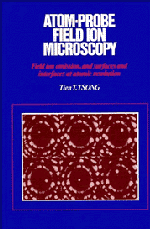 Atom-Probe Field Ion Microscopy
Atom-Probe Field Ion Microscopy Published online by Cambridge University Press: 30 October 2009
Early developments
The field ion microscope (FIM) is the first microscope to have achieved atomic resolution. It is a surprisingly simple instrument (though the simplicity is somewhat deceptive), consisting of a sample in the form of a tip and a phosphorus screen some 10 cm away. To obtain an atomic image, one has only to introduce about 10−4 Torr of an image gas such as He into the system, cool down the sample tip below liquid nitrogen temperature and apply a positive voltage to the tip and raise the tip voltage gradually. When the field at the tip surface reaches about 4 V/Å, an atomic image will start to appear. This simple instrument is an outgrowth of field emission microscope, invented by Miiller in 1936. In a field emission microscope, the sample is also a sharp tip. In ultra-high vacuum, a negative voltage is applied to the tip. When the field at the nearly hemispherical tip surface reaches a value above ˜0.3 V/Å, electrons are emitted out of the surface by the quantum mechanical tunneling effect. These electrons are projected onto a phosphorus screen some 10 cm away to form an image of the surface. As the electron current density depends very sensitively on the work function of the surface, the greatly magnified, radial projection image of the field emitted electrons represents a map of the work function variation of the surface. These field emitted electrons originate mostly from the vicinity of the Fermi level. They have a relatively large kinetic energy and therefore a relatively large velocity component in the lateral direction of the surface.
To save this book to your Kindle, first ensure [email protected] is added to your Approved Personal Document E-mail List under your Personal Document Settings on the Manage Your Content and Devices page of your Amazon account. Then enter the ‘name’ part of your Kindle email address below. Find out more about saving to your Kindle.
Note you can select to save to either the @free.kindle.com or @kindle.com variations. ‘@free.kindle.com’ emails are free but can only be saved to your device when it is connected to wi-fi. ‘@kindle.com’ emails can be delivered even when you are not connected to wi-fi, but note that service fees apply.
Find out more about the Kindle Personal Document Service.
To save content items to your account, please confirm that you agree to abide by our usage policies. If this is the first time you use this feature, you will be asked to authorise Cambridge Core to connect with your account. Find out more about saving content to Dropbox.
To save content items to your account, please confirm that you agree to abide by our usage policies. If this is the first time you use this feature, you will be asked to authorise Cambridge Core to connect with your account. Find out more about saving content to Google Drive.